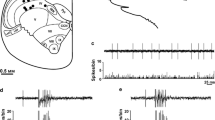Abstract
A comparative analysis of changes in the functional state of the oral and caudal trigeminal nuclei after electroacupuncture was undertaken in acute experiments on adult cats anesthetized with hexobarbital (50 mg/kg, intraperitoneally). Electroacupuncture was shown to inhibit evoked potentials arising in the caudal nucleus as a result of stimulation of the pulp, but not to change evoked potentials in response to stimulation of the mucosal surface of the lip. Electroacupuncture in the oral nucleus facilitated responses to both types of stimulation. Systemic injection of morphine (5 mg/kg, intravenously) gave similar results. It is suggested that the ventromedial part of the caudal nucleus facilitates the arrival of the diffuse component of the nociceptive signal in the nonspecific projection system, whereas the oral nucleus participates in conduction of information on possible injury to the structures of the oral cavity and realization of the necessary protective reactions.
Similar content being viewed by others
Literature cited
R. A. Durinyan, "The physiological basis of pain and reflex analgesia," Vestn. Akad. Med. Nauk SSSR, No. 9, 38 (1980).
G. P. Zhukova, "The neuronal structure and interneuronal connections of the brain stem and spinal cord," Author's Abstract of Dissertation for the Degree of Doctor of Medical Sciences, Moscow (1975).
O. N. Moskovets, V. K. Reshetnyak, and R. A. Durinyan, "Electroacupuncture inhibition of nociceptive responses in the caudal trigeminal nucleus," Byull. Éksp. Biol. Med.,89, No. 1, 7 (1980).
O. N. Moskovets, "Effect of auricular electroacupuncture on the motor manifestations of nociceptive reactions," Byull. Éksp. Biol. Med.,89, No. 4, 401 (1980).
V. K. Reshetnyak, E. E. Meizerov, and R. A. Durinyan, "Effect of electroacupuncture on integration of nociceptive and non-nociceptive signals in the second somatosensory area of the cortex," Byull. Éksp. Biol. Med.,93, No. 3, 11 (1982).
R. K. Andersen, J. P. Lund, and E. Puil, "Enkephalin and substance P effects related to trigeminal pain," Can. J. Physiol. Pharmacol.,56, No. 2, 216 (1978).
J. Azerad, A. Woda, and D. Albe-Fessard, "Physiological properties of neurons in different parts of cat trigeminal sensory complex," Brain Res.,246, No. 1, 7 (1982).
A. L. Berman, The Brain Stem of the Cat. A Cytoarchitectonic Atlas with Stereotaxis Coordinates, Madison, Wisconsin (1968).
J. O. Dostrovsky, B. J. Sessle, and J. W. Hu, "Presynaptic excitability changes produced in brain stem endings of tooth pulp afferents by raphe and other central and peripheral influences," Brain Res.,218, No. 1/2, 141–160 (19 ).
L. F. Greenwood and B. J. Sessle, "Pain, brain stem mechanisms and motor function," in: Mastication and Swallowing: Biological and Clinical Correlates, ed. B. J. Sessle and A. G. Hannan, Univ. Toronto Press, Toronto (1976), pp. 108–119.
J. L. Henry, B. J. Sessle, G. E. Lucier, and J. W. Hu, "Effects of substance P on nociceptive and non-nociceptive trigeminal brain stem neurons," Pain,8, No. 1, 33 (1980).
J. W. Hu, J. O. Dostrovsky, and B. J. Sessle, "Functional properties of neurons in cat trigeminal subnucleus caudalis (medullary dorsal horn). 1. Responses to oral-facial noxious and non-noxious stimuli and projections to thalamus and subnucleus oralis," J. Neurophysiol.,45, No. 2, 173 (1981).
S. Kawamura, "Efferent projections of the nucleus caudalis of the spinal trigeminal complex in the cat," Okujimas Folia Anat. Jpn.,47, No. 6, 377 (1971).
B. Matthews, "Functions of tooth pulp afferents," in: Advances in Pain Research and Therapy, ed. J. J. Bonica et al., Vol. 3, Raven Press, New York (1979), pp. 261–263.
T. Nagata and L. Kruger, "Tactile neurons of the superior colliculus of cat: input and physiological properties," Brain Res.,174, No. 1, 19 (1979).
O. Sjöqvist, "Studies on pain condition in the trigeminal nerve; a contribution to the surgical treatment of facial pain," Acta Psychiat. Neurol. Scand.,17, Suppl. 1, 1 (1938).
W. A. Steward, W. L. Stoops, P. R. Pillone, and R. B. King, "An electrophysiological study of ascending pathways from nucleus caudalis of the spinal trigeminal nuclear complex," J. Neurosurg.,21, No. 1, 35 (1964).
R. Sumino and S. Nozaki, "Trigemino-neck reflex: its peripheral and central organization," in: Pain in Trigeminal Region, ed. D. J. Anderson and B. Matthews, Elsevier, Amsterdam (1977), pp. 365–374.
L. E. Westrum, R. C. Canfield, and T. A. O'Connor, "Each canine tooth projects to all brain stem trigeminal nuclei in cat," Exp. Neurol.,74, No. 3, 787 (1981).
Additional information
Central Research Institute of Reflex Therapy, Main Health Board, Moscow. Translated from Neirofiziologiya, Vol. 17, No. 2, pp. 147–152, March–April, 1985.
Rights and permissions
About this article
Cite this article
Dolgikh, V.G., Durinyan, R.A. & Reshetnyak, V.K. Effect of electroacupunture and morphine on evoked potentials in the oral and caudal trigeminal nuclei of the cat. Neurophysiology 17, 91–95 (1985). https://doi.org/10.1007/BF01052941
Received:
Issue Date:
DOI: https://doi.org/10.1007/BF01052941



